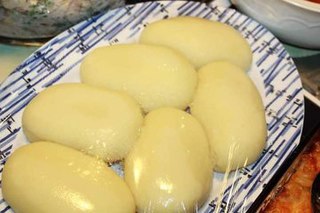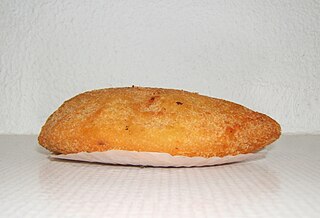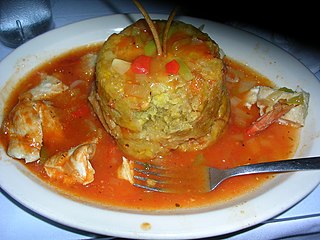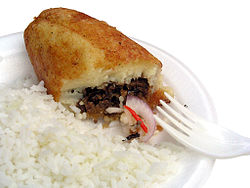
Cooking bananas are banana cultivars in the genus Musa whose fruits are generally used in cooking. They may be eaten ripe or unripe and are generally starchy. Many cooking bananas are referred to as plantains or 'green bananas'. In botanical usage, the term "plantain" is used only for true plantains, while other starchy cultivars used for cooking are called "cooking bananas". True plantains are cooking cultivars belonging to the AAB group, while cooking bananas are any cooking cultivar belonging to the AAB, AAA, ABB, or BBB groups. The currently accepted scientific name for all such cultivars in these groups is Musa × paradisiaca. Fe'i bananas from the Pacific Islands are often eaten roasted or boiled, and are thus informally referred to as "mountain plantains", but they do not belong to any of the species from which all modern banana cultivars are descended.

Latin American cuisine is the typical foods, beverages, and cooking styles common to many of the countries and cultures in Latin America. Latin America is a highly racially, ethnically, and geographically diverse with varying cuisines. Some items typical of Latin American cuisine include maize-based dishes arepas, empanadas, pupusas, tacos, tamales, tortillas and various salsas and other condiments. Sofrito, a culinary term that originally referred to a specific combination of sautéed or braised aromatics, exists in Latin American cuisine. It refers to a sauce of tomatoes, roasted bell peppers, garlic, onions and herbs. Rice, corn, pasta, bread, plantain, potato, yucca, and beans are also staples in Latin American cuisine.

Fufu is a pounded meal found in West African cuisine. It is a Twi word that originates from the Akans in Ghana. The word has been expanded to include several variations of the pounded meal found in other African countries including Sierra Leone, Guinea, Liberia, Cote D'Ivoire, Burkina Faso, Benin, Togo, Nigeria, Cameroon, the Democratic Republic of Congo, the Central African Republic, the Republic of Congo, Angola, and Gabon.

A rissole is a small patty enclosed in pastry or rolled in breadcrumbs, usually baked or deep fried. The filling has savory ingredients, most often minced meat, fish or cheese, and is served as an entrée, main course, or side dish.
Peruvian cuisine reflects local practices and ingredients including influences mainly from the indigenous population, including the Inca, and cuisines brought by immigrants from Europe, Asia, and Africa. Without the familiar ingredients from their home countries, immigrants modified their traditional cuisines by using ingredients available in Peru.

A gordita in Mexican cuisine is a dish made with masa and stuffed with cheese, meat, or other fillings. It is similar to the Colombian and Venezuelan arepa. Gordita means "chubby" in Spanish. There are two main variations of this dish, one of which is typically fried in a deep wok-shaped comal, consumed mostly in central and southern Mexico, and another one baked on a regular comal. The most common and representative variation of this dish is the "gordita de chicharrón", filled with chicharron which is widely consumed throughout Mexico. Gorditas are often eaten as a lunch dish and accompanied by several types of sauce.

Mofongo is a dish from Puerto Rico with plantains as its main ingredient. Plantains are picked green, cut into pieces and typically fried but can be boiled or roasted, then mashed with salt, garlic, broth, and olive oil in a wooden pilón. The goal is to produce a tight ball of mashed plantains that will absorb the attending condiments and have either pork cracklings (chicharrón) or bits of bacon inside. It is traditionally served with fried meat and chicken broth soup. Particular flavors result from variations that include vegetables, chicken, shrimp, beef, or octopus packed inside or around the plantain orb.

A buñuelo (Spanish:[buˈɲwelo], alternatively called boñuelo, bimuelo, birmuelo, bermuelo, bumuelo, burmuelo, or bonuelo, is a fried dough fritter found in Spain, Latin America, and other regions with a historical connection to Spaniards, including Southwest Europe, the Balkans, Anatolia, and other parts of Asia and North Africa. Buñuelos are traditionally prepared at Christmas. It will usually have a filling or a topping. In Mexican cuisine, it is often served with a syrup made with piloncillo.
Green bananas are unripe bananas used in cuisines worldwide. They have a firmer texture and a starchy, mildly astringent taste compared to their ripe counterparts.

Picadillo is a traditional dish in many Latin American countries including Mexico and Cuba, as well as the Philippines. It is made with ground meat, tomatoes, and also raisins, olives, and other ingredients that vary by region. The name comes from the Spanish word picar, meaning "to mince".

Cuchifritos or cochifritos refers to various fried foods prepared principally of pork in Spanish and Puerto Rican cuisine. In Spain, cuchifritos are a typical dish from Segovia in Castile. The dish consists of pork meat fried in olive oil and garlic and served hot. In Puerto Rico they include a variety of dishes including morcilla, papas rellenas, and chicharron, and other parts of the pig prepared in different ways. Some cuchifritos dishes are prepared using plantain as a primary ingredient. Cuchifritos vendors also typically serve juices and drinks such as passionfruit, pineapple, and coconut juice, as well as ajonjolí, a drink made from sesame seeds.

Dominican cuisine is made up of Spanish, indigenous Taíno, Middle Eastern, African, Cuban, Puerto Rican and Haitian influences. The most recent influences in Dominican cuisine are from the British West Indies and China.

Fried potatoes are a dish or a component of other dishes essentially consisting of potatoes which have been fried or deep-fried in hot cooking oil often with the addition of salt and other seasonings. They are often served as a side dish.

A great variety of cassava-based dishes are consumed in the regions where cassava is cultivated, and the ingredient is included many national or ethnic specialities.

A croquette is a deep-fried roll originating in French cuisine, consisting of a thick binder combined with a filling, which is then breaded. It is served as a side dish, a snack, or fast food worldwide.

Dumpling is a broad class of dishes that consist of pieces of cooked dough, often wrapped around a filling. The dough can be based on bread, wheat or other flours, or potatoes, and it may be filled with meat, fish, tofu, cheese, vegetables, or a combination. Dumplings may be prepared using a variety of cooking methods and are found in many world cuisines.














